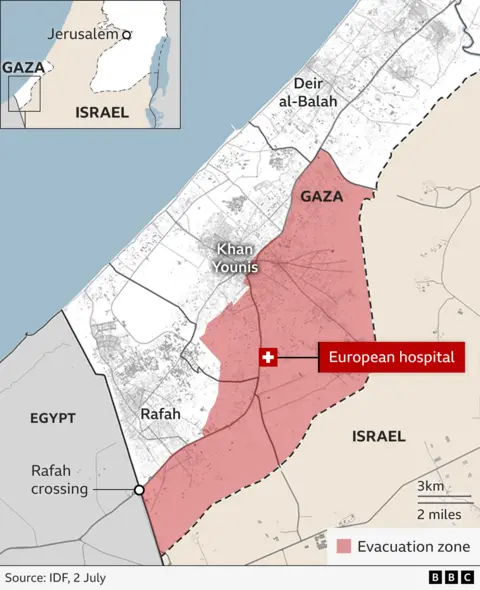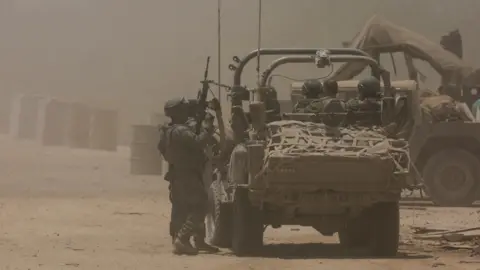Gazans seek shelter as Khan Younis exodus continues
Tens of thousands of Palestinians are seeking shelter and a safe location, as the exodus from Gaza’s second city of Khan Younis continues in response to Israeli military evacuation orders.
The UN estimates that 250,000 people in eastern parts of the city are affected by the orders issued on Monday, which suggest Israeli forces are set to re-enter.
Reports say an Israeli air strike on Tuesday killed 12 Palestinians in an Israeli-designated humanitarian area to which people have been told to flee.
A major hospital in Khan Younis also now stands empty, after all its patients and medical personnel left.
Much of the city was destroyed in a long Israeli offensive earlier this year, but large numbers of Palestinians had moved there to escape another Israeli operation in nearby Rafah.
Explosions, shelling and gunfire were also heard throughout Gaza City on Wednesday as Israeli forces continue to battle Hamas and other armed groups in the eastern Shejaiya district for a seventh day.
The Israeli military launched a campaign in Gaza to destroy Hamas in response to an unprecedented attack on southern Israel on 7 October, during which about 1,200 people were killed and 251 others were taken hostage.
More than 37,950 people have been killed in Gaza since then, according to the territory’s Hamas-run health ministry.

Speaking from Nuseirat refugee camp in central Gaza, Louise Wateridge of the UN agency for Palestinian refugees (Unrwa) told the BBC that its staff on the ground had been observing the “very chaotic” movement of civilians from eastern Khan Younis.
“[It’s] different from previous displacements, when we’ve seen trucks and vehicles loaded up,” she said.
“There are limited vehicles available, there’s limited fuel, the roads are so dangerous, the situation is so unsafe. People are really at this stage carrying what they can in their hands and moving. It’s devastating.”
Marwan, a father of four who has a pregnant wife, told the BBC that it had taken his family three hours to travel about 7km (4 miles) on a donkey-pulled cart from Khan Younis to al-Mawasi, which is inside a Israeli-designated “humanitarian area” that lacks basic services.
“We left in a rush, so we couldn’t get all of our luggage and important things,” he said. “I called a friend who resides in al-Mawasi. He told me there is a place next to me and you can come.”
He added: “For the bathroom, I have to dig in the sand and the mud and make a big hole.”
On Tuesday afternoon, nine members of an extended family who had fled Khan Younis were reportedly among 12 people killed in an Israeli air strike on a residential building in the central town of Deir al-Balah, which is also inside the “humanitarian area”.
The Associated Press cited hospital records as saying that Dr Hossam Hamdan, a 62-year-old dermatologist, his wife, their adult son and daughter were among the dead. Four of Dr Hamdan’s grandchildren and the mother of two of them were also killed, along with two other residents of the building and a man who was on the street outside, it added.
The Israel Defense Forces (IDF) said it was checking the reports.
 Reuters
ReutersLate on Tuesday, the World Health Organization announced that the European Gaza hospital in eastern Khan Younis was completely empty, after its 320 patients and all of its medical staff left in response to an evacuation order for the surrounding area.
Most of the patients had been referred to Nasser hospital, which was now at full capacity and had a shortage of medical supplies and drugs for surgery, it warned.
“European Gaza Hospital – one of the largest referral hospitals in the south – must be protected and made operational immediately. Gaza cannot afford to lose more hospitals,” wrote WHO chief Dr Tedros Adhanom Ghebreyesus on X, formerly Twitter.
An Israeli defence agency said it did not order the European hospital’s patients and staff to leave. But the head of the emergency department said the Hamas-run health ministry had said they should evacuate.
A spokeswoman for the Israeli embassy in London, Orly Goldschmidt, said the evacuation orders were part of Israel’s efforts to minimise civilian casualties and accused Hamas members of embedding themselves in residential areas.
“We know that they are also hiding in Khan Younis and we want the civilian population to be out of it, so that we won’t harm the Palestinian population and only kill Hamas members,” she told the BBC on Tuesday.
The IDF has not announced the start of an operation in eastern Khan Younis. But the evacuation orders are seen as a sign that it will be the next area to be re-entered by Israeli troops because they believe Hamas and allied fighters have regrouped there.
Palestinian Islamic Jihad (PIJ) said on Monday that it had fired a barrage of about 20 rockets from Khan Younis towards border communities in southern Israel. It was the heaviest such attack from Gaza in months, but no casualties were reported.
Another 80,000 Palestinians in northern Gaza are estimated to have been affected by Israeli evacuation orders covering Gaza City’s eastern Shejaiya district, which Israeli troops re-entered last week.
Medics told Reuters news agency that four people had been killed in an air strike there on Wednesday, while the IDF said it had struck and dismantled more than 50 “terrorist infrastructure sites” over the past day.
The IDF also said strikes had killed “terrorists who posed a threat” to its troops in central Gaza. Local health officials said three people had been killed in a strike on a car in Deir al-Balah, and that another five had been killed in two strikes in the nearby urban Maghazi refugee camp.
In the southernmost city of Rafah, Israeli forces were reported to have shelled several areas in the city and continued to demolish apartment blocks.
The IDF said a “targeted” operation was continuing in Rafah and that ground forces backed by aircraft had “dismantled several terror infrastructure sites and eliminated terrorists”.



